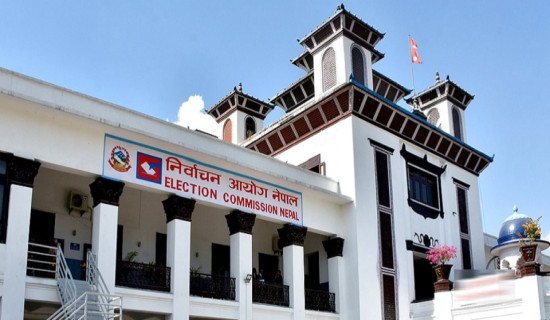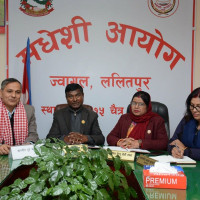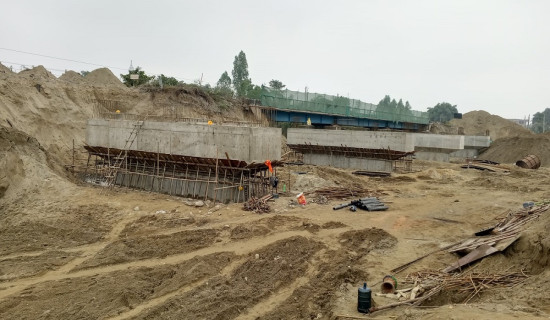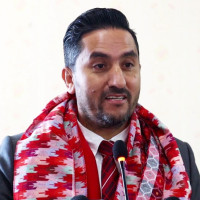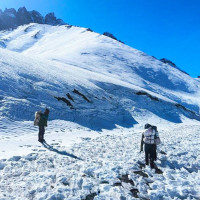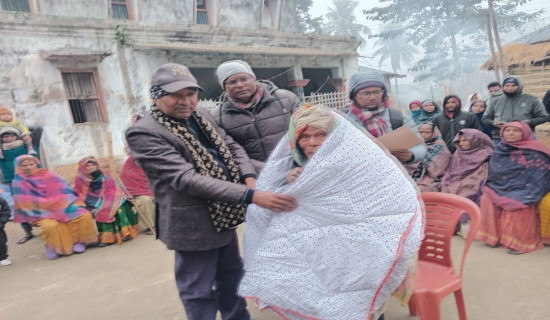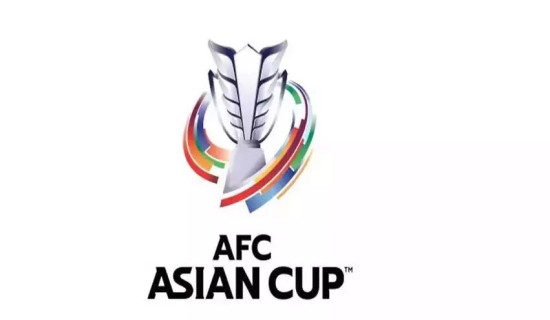- Thursday, 8 January 2026
From passion to profession: Bridging gap for Nepal's aspiring athletes
Kathmandu & Biratnagar, May 5: During the central selection of U-13 footballers, the All Nepal Football Association (ANFA) received over 700 boys from seven provinces. After a four-day selection process at the Lalitpur-based Chyasal Stadium in April, 75 boys and 25 girls were selected to be trained at ANFA Academies in Dharan, Sisneri and Butwal with all costs – education, food and lodging – covered by the football’s governing body.
The 100 selected children hail from over 35 districts of seven provinces. Meanwhile, of them, only two boys – Sandeep Sejuwal (Jumla) and Nilesh Shahi (Surkhet) – were from Karnali. Karnali had sent 39 boys and three girls from the province for the central selection.
On the other hand, 14 of the 75 selected boys were from Jhapa district alone. Moreover, 24 of the 75 boys and six of the 25 girls hailed from Koshi Province alone.
Wilful but untrained
“The difference in the number of emerging footballers selected from Karnali and Koshi is a result of the difference in their skills and technicalities. Many children with better physicality and stamina were overshadowed by those with better knowledge of the game,” said Nabin Neupane, ANFA’s Head of Academies.
According to Neupane, every boy and girl in the final selections loved football and played it often;
however, they lacked a proper coach/trainer to teach them the best way to play football.
“Meanwhile, we were amazed to see wilful girls in the selections as they were extremely motivated by Nepal’s women football squad and their performance at the recently concluded WAFF Championship,” Neupane added.
It is not much of a surprise as Nepal’s Sabitra Bhandari ‘Samba’ has reached the greatest heights of a Nepali footballer. Samba, as the first Nepali to do so, currently plays in a top-tier European league in France, the first Nepali to do so. She is also the leading female goal scorer of South Asia and the record scorer of Nepal among boys and girls.
Moreover, the President Running Shield provides a clearer view on how the wilful children have not received proper training.
“I was motivated by my friends to participate in the high jump at the local-level selection for the 14th President Running Shield. Surprisingly, representing Redstar English Boarding School, I jumped the highest in Pathari-Shanishchare Municipality and got selected for Morang’s district-level selection,” said Samir Raut, a teenager from Shanishchare.
Raut was awestruck when he visited Biratnagar for the district-level selection. “In Biratnagar, I found that I did not even know the correct way to jump, yet I jumped the highest at my local level. I had no prior experience or training in high jump. I could not progress further, but I was happy that I gave my best,” Raut said.
According to senior coaches, they too felt saddened to see wilful but untrained children doing their best in their respective sports.
“We can identify promising talents at the sight. However, we can also recognise the basic skills and knowledge they lack,” said Sushil Narsingh Rana, Nepal’s former chief coach of
Coaching resources underutilised
“Of the five national junior records broken in the 14th President Running Shield, four were broken by athletes from Karnali and Sudurpashchim. It shows that many junior athletes can continue improving records every year if they are trained properly for it,” said Rana.
“There is no better place than a school where children can be encouraged towards certain sports as per their capabilities. However, there are neither sports teachers nor coaches in schools. There are also no academic courses related to sports at the school level,” Rana, who is also a World Level II middle and long-distance coach and assistant lecturer, lamented.
It is not that Nepal lacks coaches. “We do not have enough coaches, but we have a good number of them. Provincial governments have their sports’ governing bodies. However, due to unclear laws after federalism, we have neither been able to use central coaches nor hire permanent coaches easily,” said Binod Pandey, a sixth-level officer at the Koshi Sports Development Board.
“There are around 90 coaches under the National Sports Council in Koshi. However, two districts – Solukhumbu and Tehrathum – have no coaches at all,” added Pandey.
Bishwamitra Sanjyal, member-secretary at the Karnali Sports Development Council, also shared a similar problem with coaches.
“Karnali’s athletes could break two national junior records at the 14th President Running Shield as they were coached by senior and experienced coaches such as Bikram Jung Thapa and Hari Bahadur Rokaya for around a month. If not, the records might not have been bettered,” said Sanjyal.
According to Sanjyal, there are no official athletics coaches in any district of Karnali except Surkhet.
Likewise, the available coaches associated with the National Sports Council and deployed in different districts reflected upon their respective problems.
“The monthly salary for a district-level football coach is Rs. 12,000. This month’s salary is released a couple of months later. The availability of infrastructure and resources to train the new generation is out of the box,” said Mahesh Budthapa, Jumla’s District Football Coach.
“The other challenge is to train the whole of Jumla. I cannot reach the corners of the district and the locals cannot arrive easily in the district headquarters. I felt sorry for many children who came for the U-13 district-level selections as they had the motivation but no skills,”
Budthapa added.
Retaining athletes
“It is not the first time that records were broken at the President Running Shield. A record broker can challenge professional foreign athletes in the future. However, if we search for junior athletes who bettered the records earlier, they are nowhere to be found,” said former national athleticschief coach Rana.
According to Rana, a promising athlete should be retained and trained regularly. “An athlete cannot show the best results at the beginning. It is possible when an athlete reaches his/her peak at a certain maturity level with continuous training. We can see athletes aged 40 years old and above breaking international records.”
According to the Karnali Sports Development Council, the medallists of the province in the 14th President Running Shield are being trained for the 10th National Games and the provincial government is providing them with a monthly allowance of Rs. 5,000.
“However, we doubt if the athletes can be retained for long as there are challenges galore,” said Sanjyal.
The best way to retain athletes, as per the stakeholders, is to organise more and more tournaments.
Meanwhile, despite communities organising big events for their local talents, the governments have failed to do so. For example, the organisation of Gold Cups and other tournaments by local communities across the country have given a platform to play and at least earn something from sports to hundreds of youngsters.
Organisers of the Birat Gold Cup, Itahari Gold Cup and Jhapa Gold Cup informed that they organise the tournaments to allow their local talents to play with bigger teams and get recognised to progress further.
Expressing how the Rastriya Jagriti Club has been organising the Gold Cup in Itahari and completed its 14th edition recently, club’s member Rabin Gautam said, “In our club, we are preparing a new generation in football with the support of our community. We locals also played football in our younger days but could not reach a good platform, but we want our youngsters to realise that dream.”
“It costs over Rs. 10 million to organise the Gold Cup as we provide an allowance for the travel, lodging and food of the invited teams. The money is collected from the local communities and businesses alongside the support from government authorities,” said Kishor Shahi, chairman of Birat Gold Cup Trust, the organiser
of Birat Gold Cup.
Promising year ahead?
According to former chief coach Rana, coaches and officials from other countries were mouth-watered by Nepal’s President Running Shield’s format when he presented on the tournament in a programme in Singapore.
“The format of President Running Shield is great as the new talents compete in the local, district and provincial levels before arriving in Kathmandu for the central-level tournament. However, we need to make it more competitive by training the emerging talents,” Rana stressed.
According to the stakeholders and authorities, Nepal’s sports sector can be a platform to earn a decent livelihood if there is enough support: sponsorships from private companies and a sufficient budget from the government.
Nepal men’s cricket is a sports team with good sponsorship from private companies. It is a result of their achievements in the global platform.
“Sports will receive sponsorship if it is competitive and professional. It is possible if the participants are well trained and skilful to entertain the viewers,” said Rana.
While the prospect of private sponsorship is unknown, the government has been ensuring a good year ahead for sports.
Prime Minister Pushpa Kamal Dahal ‘Prachanda’, on several occasions, has stated that the government is increasing the budget for sports in the upcoming fiscal year 2024/25 and has prioritised the construction of three cricket stadiums – Gautam Buddha Stadium in Chitwan, Girija Prasad Koirala Stadium in Morang and Mulpani Cricket Stadium in Kathmandu – by designating them as national pride projects.
Nepal needs the stadiums as the men’s squad has a high chance of becoming a Test nation with good infrastructure.
Similarly, Biraj Bhakta Shrestha, the Minister for Youth and Sports, has also assured a quality year ahead for sports. Addressing the inauguration of the 14th President Running Shield central tournament in Kathmandu, Minister Shrestha assured to make the next edition of the tournament more extravagant and fruitful.
Minister Shrestha’s move to safeguard stadiums and restrict unnecessary foreign travels of sports officials alongside National Sports Council’s member-secretary Tanka Lal Ghising’s move to end politics in sports – for instance, by reducing the number of several associations in a single sport – will likely turn beneficial soon as well.



